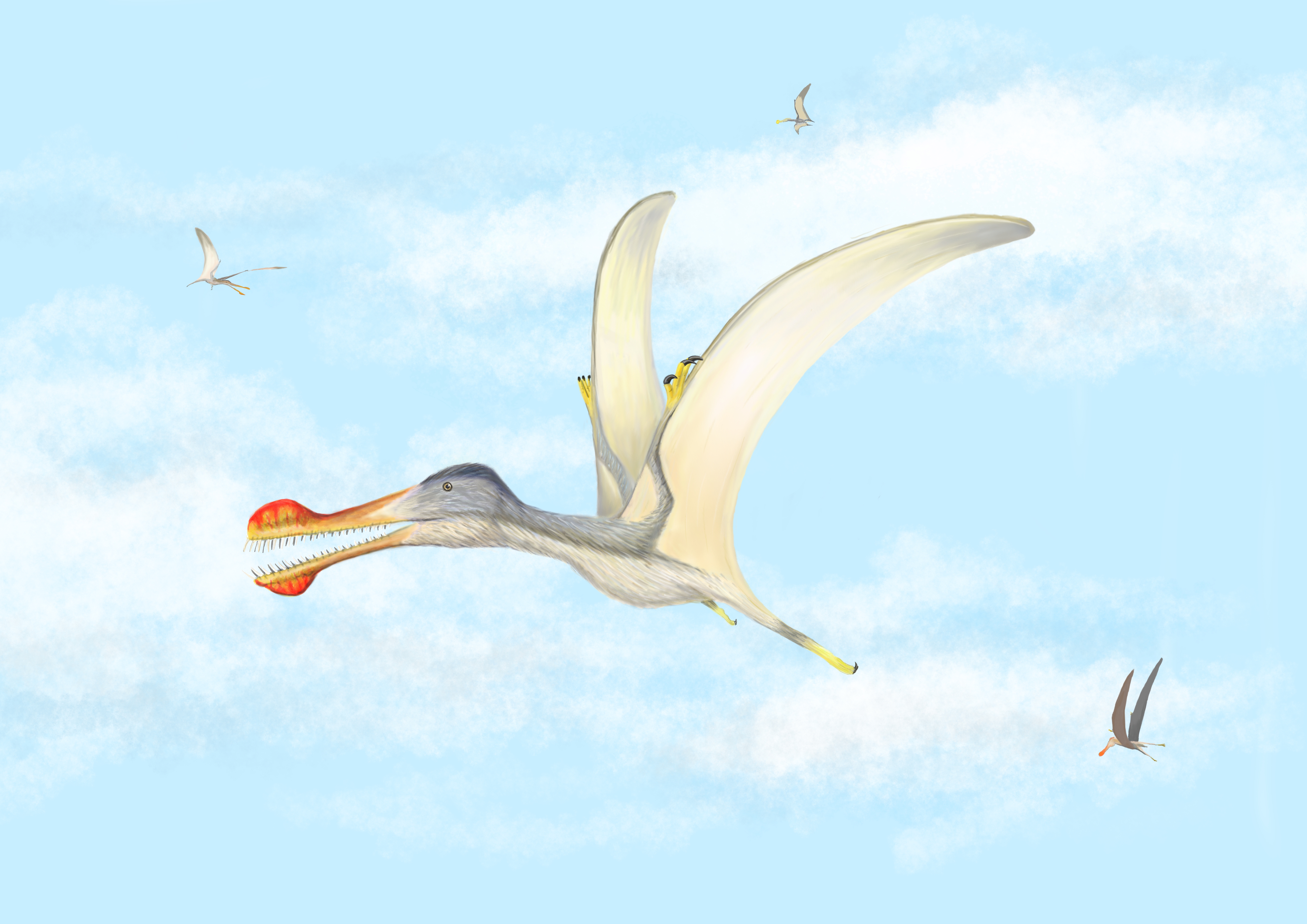Fossil Discoveries Give Clues about Flying, Spike-toothed Reptiles in the Sahara 100 Million Years Ago

Anhanguera soaring the skies over the Kem Kem with Coloborhynchus and Ornithocheirus
(Art by Megan Jacobs)
Fish-eating pterosaurs with wingspans of up to 13 feet soared and snatched prey, Baylor University researcher says
Media Contact: Terry Goodrich, Baylor University Media and Public Relations, 254-644-4155
Follow us on Twitter: @BaylorUMedia
WACO, Texas (March 24, 2020) – Three new species of toothed pterosaurs — flying reptiles of the Cretaceous period, some 100 million years ago — have been identified in Africa by an international team of scientists led by Baylor University.
The pterosaurs, which soared above a world dominated by predators, formed part of an ancient river ecosystem in Africa that teemed with life including fish, crocodiles, turtles and several predatory dinosaurs.
“Pterosaur remains are very rare, with most known from Europe, South America and Asia. These new finds are very exciting and provide a window into the world of pterosaurs in Cretaceous Africa,” said lead author Megan L. Jacobs, a doctoral candidate in geosciences at Baylor University.
The study, published in the journal Cretaceous Research, is helping to uncover the poorly known evolutionary history of Africa during the time of the dinosaurs. The research finds that African pterosaurs were quite similar to those found on other continents. Their world included crocodile-like hunters and carnivorous dinosaurs, with few herbivores. Many predators, including the toothed pterosaurs, preyed on a superabundance of fish.
“For such large animals, they would have weighed very little,” Jacobs said. “Their wingspans were around 10 to 13 feet, with their bones almost paper-thin and full of air, very similar to birds. This allowed these awesome creatures to reach incredible sizes and still be able to take off and soar the skies.”
Pterosaurs snatched up their prey while on the wing, using a set of large spike-like teeth to grab. Large pterosaurs such as these would have been able to forage over hundreds of miles, with fossil evidence showing they flew between South America and Africa, similar to present-day birds such as condors and albatrosses, researchers said.
The specimens — identified by researchers from chunks of jaws with teeth — were obtained from fossil miners in a small village called Beggaa, just outside Erfoud in southeast Morocco. These villagers daily climb halfway up the side of a large escarpment, known as the Kem Kem Beds, to dig in a layer of coarse sand, the most fossiliferous bed.
“They excavate everything they find, from teeth to bones to almost complete skeletons,” Jacobs said. “They then sell their finds to dealers and scientists who conduct fieldwork, ensuring the villagers make enough money to survive while we get new fossils to describe. These pterosaur fragments are unique and can be identified easily — if you know what to look for.”
One of the species, Anhanguera, previously was only known to be from Brazil. Another, Ornithocheirus, had until now only been found in England and Middle Asia.
This year’s find brings to five the total of toothed pterosaurs whose remains have been found in the Kem Kem beds, with the first described in the 1990s and the second one last year, Jacobs said. The specimens will be part of an acquisition in a museum in Morocco.
*The research team included scientists of biology, geology and paleontology from the University of Portsmouth, the University of Leicester and the University of Bath, all in England; Detroit Mercy University in Detroit, Michigan; and Université Hassan II in Morocco, Africa.
ABOUT BAYLOR UNIVERSITY
Baylor University is a private Christian University and a nationally ranked research institution. The University provides a vibrant campus community for more than 17,000 students by blending interdisciplinary research with an international reputation for educational excellence and a faculty commitment to teaching and scholarship. Chartered in 1845 by the Republic of Texas through efforts of Baptist pioneers, Baylor is the oldest continually operating University in Texas. Located in Waco, Baylor welcomes students from all 50 states and more than 90 countries to study a broad range of degrees among its 12 nationally recognized academic divisions.
ABOUT THE COLLEGE OF ARTS & SCIENCES AT BAYLOR UNIVERSITY
The College of Arts & Sciences is Baylor University’s oldest and largest academic division, consisting of 25 academic departments and seven academic centers and institutes. The more than 5,000 courses taught in the College span topics from art and theatre to religion, philosophy, sociology and the natural sciences. Faculty conduct research around the world, and research on the undergraduate and graduate level is prevalent throughout all disciplines. Visit www.baylor.edu/artsandsciences.